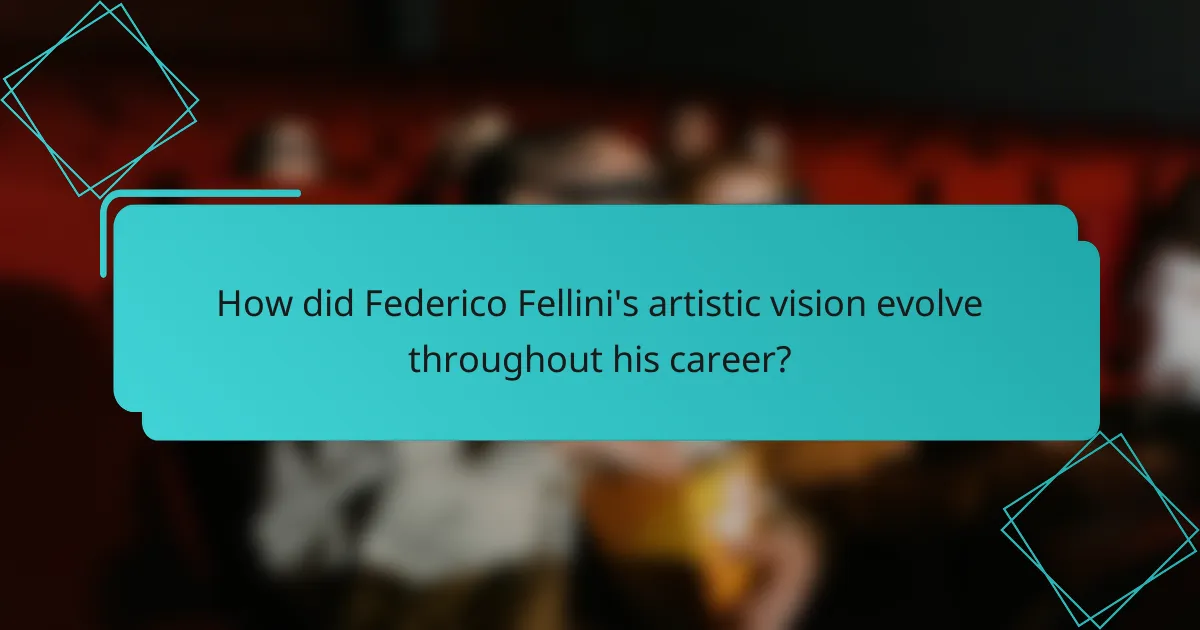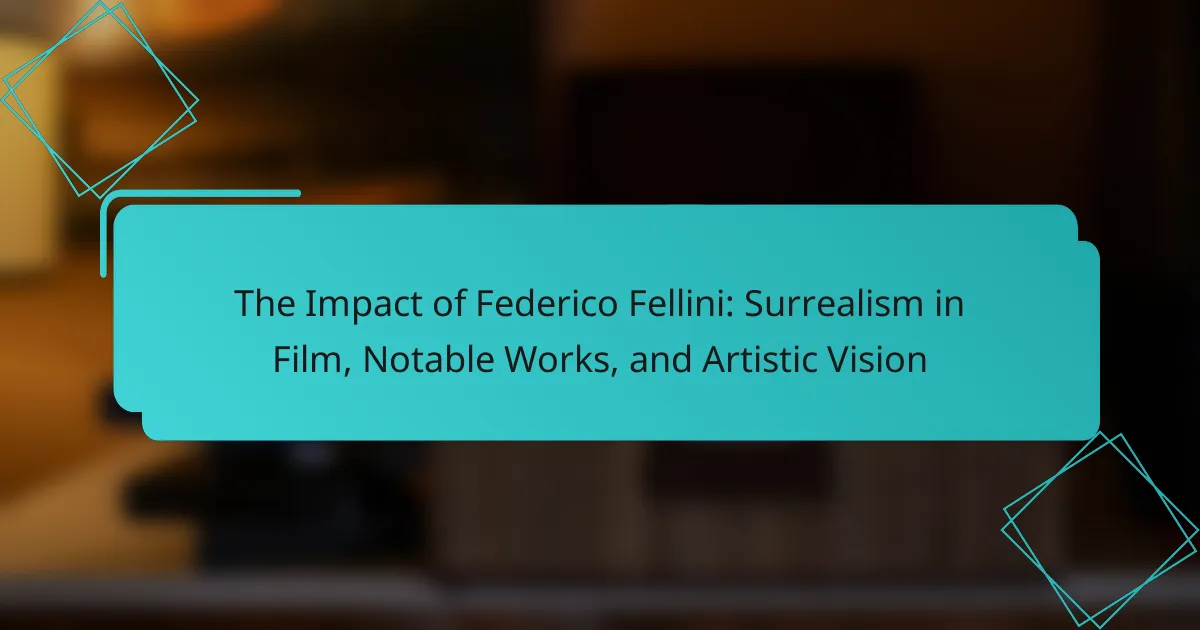Federico Fellini is a pivotal figure in the realm of surrealism in film, known for his distinctive integration of fantasy and reality. His notable works, including “La Dolce Vita,” “8½,” and “Amarcord,” highlight his unique style, characterized by dreamlike sequences and vivid imagery that challenge traditional narrative forms. The article examines Fellini’s artistic evolution from neorealism to surrealism, exploring themes of identity, desire, and the subconscious. It also discusses his profound influence on contemporary filmmakers and the lasting impact of his cinematic legacy on the surrealist genre.

What is the significance of Federico Fellini in the realm of surrealism in film?
Federico Fellini is significant in the realm of surrealism in film for his unique blend of fantasy and reality. His films often feature dreamlike sequences that challenge conventional narrative structures. Works like “8½” and “La Dolce Vita” exemplify his surrealistic style. Fellini’s use of vivid imagery and symbolic characters creates a distinct emotional landscape. He explores themes of identity, desire, and the subconscious. Critics note that his approach influenced many filmmakers in the surrealist genre. His artistic vision continues to resonate in contemporary cinema. Fellini’s legacy is marked by a profound impact on the evolution of surrealist filmmaking.
How did Federico Fellini’s early life influence his artistic vision?
Federico Fellini’s early life significantly shaped his artistic vision. He was born in Rimini, Italy, in 1920. The coastal town’s vibrant atmosphere influenced his imagination. His childhood experiences included attending the circus, which inspired his fascination with fantasy and spectacle. Fellini’s family background was rooted in a mix of Catholicism and local folklore. This duality contributed to his exploration of [censured] and the surreal in his films. He also faced economic challenges during his youth, which heightened his awareness of human struggles. These factors combined to create a unique lens through which he viewed the world. Fellini’s early life thus laid the groundwork for his distinctive storytelling style and thematic preoccupations.
What key experiences shaped Fellini’s approach to filmmaking?
Federico Fellini’s approach to filmmaking was shaped by several key experiences. His early life in Rimini exposed him to a vibrant cultural environment. This background influenced his storytelling and visual style. Working as a cartoonist and scriptwriter in the 1940s honed his narrative skills. Collaborating with Roberto Rossellini during the neorealism movement impacted his perspective on realism. His fascination with dreams and the subconscious was influenced by his personal experiences and interactions. Fellini’s travels across Europe enriched his artistic vision. The blending of fantasy and reality became a hallmark of his films. These experiences collectively defined his unique cinematic style.
How did his cultural background impact his surrealist style?
Federico Fellini’s cultural background significantly influenced his surrealist style. He grew up in a small Italian town, which exposed him to rich folklore and local traditions. This upbringing instilled a sense of nostalgia and dreamlike qualities in his narratives. Additionally, the Catholic imagery prevalent in Italy shaped his visual motifs and themes of [censured]. His experiences during World War II also contributed to a deep sense of absurdity and existentialism in his work. Fellini often incorporated elements of his childhood memories, blending reality with fantasy. This synthesis created a unique surrealist aesthetic that resonated with audiences. His films reflect a personal and cultural exploration of identity, dreams, and the subconscious.
What are the defining characteristics of Fellini’s surrealism?
Fellini’s surrealism is characterized by dreamlike imagery and fantastical elements. His films often blend reality with imagination. This creates a unique narrative style that defies conventional storytelling. He employs exaggerated characters and bizarre scenarios. These elements reflect the subconscious mind and emotional experiences. Fellini’s use of vibrant colors and striking visuals enhances the surreal atmosphere. His works often explore themes of identity and existentialism. Notable films like “8½” and “La Dolce Vita” exemplify these traits.
How does Fellini incorporate dream-like elements in his films?
Fellini incorporates dream-like elements in his films through surreal imagery and nonlinear narratives. His use of vivid colors and fantastical characters creates an otherworldly atmosphere. He often blurs the line between reality and fantasy. This technique immerses viewers in a dream-like experience. For example, in “8½,” the protagonist navigates a maze of memories and fantasies. Fellini’s unique storytelling style invites audiences to interpret their own meanings. His films often feature symbolic motifs, such as the recurring image of the circus. These elements enhance the surreal quality of his work, making it distinctively Fellinian.
What role does symbolism play in Fellini’s narratives?
Symbolism plays a crucial role in Fellini’s narratives. It serves as a tool to convey complex emotional and psychological themes. Fellini often uses symbols to reflect the inner lives of his characters. For example, the recurring motif of the circus represents the chaos of life. The use of dream sequences allows for exploration of subconscious desires. Symbols in his films often blur the line between reality and fantasy. This technique deepens the viewer’s engagement with the narrative. Fellini’s symbolism invites multiple interpretations, enriching the overall experience. His unique approach to symbolism has influenced countless filmmakers.

What are Federico Fellini’s most notable works?
Federico Fellini’s most notable works include “La Dolce Vita,” “8½,” and “Amarcord.” “La Dolce Vita,” released in 1960, explores themes of hedonism and existentialism in post-war Italy. It won the Palme d’Or at the Cannes Film Festival. “8½,” from 1963, is a semi-autobiographical film that delves into a filmmaker’s creative struggles. It received two Academy Awards for Best Foreign Language Film and Best Costume Design. “Amarcord,” released in 1973, is a nostalgic look at Fellini’s youth in a small Italian town. It won the Academy Award for Best Foreign Language Film. These films exemplify Fellini’s unique blend of surrealism and realism.
Which films are considered essential to understanding his cinematic legacy?
Essential films to understanding Federico Fellini’s cinematic legacy include “La Dolce Vita,” “8½,” and “Nights of Cabiria.” “La Dolce Vita” explores themes of hedonism and existentialism, showcasing Fellini’s unique narrative style. “8½” is a semi-autobiographical film that delves into the creative process, blending reality and imagination. “Nights of Cabiria” presents a poignant portrayal of a woman’s resilience, highlighting Fellini’s humanistic approach. These films exemplify his innovative techniques and thematic depth, solidifying his influence in cinema history.
What themes are prevalent in “La Dolce Vita”?
The prevalent themes in “La Dolce Vita” include the search for happiness, existentialism, and the critique of superficiality. The film explores the emptiness of a life focused on pleasure and fame. Characters engage in hedonistic pursuits yet remain unfulfilled. This reflects the post-war disillusionment in Italian society. Additionally, the theme of alienation is evident as characters struggle to connect with one another. The film’s surreal elements further emphasize these themes, showcasing a dreamlike quality that blurs reality. Overall, “La Dolce Vita” serves as a commentary on the complexities of modern life.
How does “8½” reflect Fellini’s artistic vision?
“8½” reflects Fellini’s artistic vision through its exploration of the creative process. The film blurs the lines between reality and imagination. It presents a protagonist, Guido, who struggles with artistic block. This struggle symbolizes Fellini’s own challenges as a filmmaker. The narrative structure is non-linear, showcasing fragmented thoughts and memories. This mirrors the chaotic nature of creativity. The use of surreal imagery emphasizes emotional truths over logical coherence. Fellini’s signature style is evident in the dreamlike sequences and whimsical characters. Overall, “8½” serves as a meta-commentary on filmmaking itself.
What impact did “Amarcord” have on the portrayal of memory in cinema?
“Amarcord” significantly impacted the portrayal of memory in cinema by blending nostalgia with surrealism. The film presents a fragmented narrative that reflects the subjective nature of memory. Fellini employs dreamlike sequences to evoke emotional truths rather than factual accuracy. This approach influences filmmakers to explore memory as a fluid and personal experience. The use of vivid imagery and symbolism in “Amarcord” highlights the emotional resonance of recollections. Critics note that this film set a precedent for future works focusing on memory’s complexities. Its legacy is evident in films that prioritize emotional over chronological storytelling. “Amarcord” redefined cinematic memory, encouraging a more introspective and artistic exploration.
How does “Amarcord” blend reality with fantasy?
“Amarcord” blends reality with fantasy through its dreamlike narrative structure. The film portrays the everyday life of a small Italian town during the 1930s. It incorporates surreal elements that reflect the protagonist’s imagination and memories. Fellini uses exaggerated characters and whimsical scenarios to enhance the fantastical aspects. The visual style features vibrant colors and imaginative set designs. These elements create a sense of nostalgia and whimsy. The film oscillates between real events and fantastical interpretations. This interplay invites viewers to question the boundaries between reality and imagination.
What unique storytelling techniques are employed in “Amarcord”?
“Amarcord” employs unique storytelling techniques such as episodic structure and surreal imagery. The episodic structure allows for a series of vignettes that capture the essence of Italian life. Each vignette presents a distinct moment, contributing to the overall narrative. Surreal imagery enhances the dreamlike quality of the film. This technique reflects Fellini’s artistic vision and personal memories. The use of non-linear storytelling further emphasizes the subjective experience of the characters. Additionally, the film incorporates a blend of humor and nostalgia. These elements create a rich tapestry of emotions and experiences. Together, these techniques distinguish “Amarcord” as a significant work in surrealist cinema.

How did Federico Fellini’s artistic vision evolve throughout his career?
Federico Fellini’s artistic vision evolved significantly throughout his career. Initially, he focused on neorealism in films like “Bicycle Thieves.” This period emphasized realistic portrayals of everyday life. As he progressed, he began incorporating surrealism and fantasy elements. Films such as “La Dolce Vita” and “8½” showcased this shift. They blended reality with dreamlike sequences. His later works featured more autobiographical themes and introspection. This evolution reflected his personal experiences and inner thoughts. Fellini’s style became increasingly imaginative and visually rich over time. His artistic journey left a lasting impact on cinema and inspired future filmmakers.
What influences shaped Fellini’s later works?
Federico Fellini’s later works were shaped by a combination of personal experiences, philosophical reflections, and artistic influences. His exploration of dreams and subconscious themes was influenced by surrealism, particularly the works of Salvador Dalí and André Breton. Additionally, Fellini’s interactions with the Italian neorealism movement impacted his narrative style, blending reality with fantasy. His personal life, including his childhood memories and relationships, also played a crucial role in his storytelling. The cultural shifts of the 1960s, including existentialism and postmodernism, further informed his artistic vision. These influences culminated in films like “8½,” which reflect his introspective journey and innovative cinematic techniques.
How did his collaborations with other artists impact his films?
Federico Fellini’s collaborations with other artists significantly enriched his films. He frequently worked with screenwriters like Ennio Flaiano and Tonino Guerra. These partnerships enhanced narrative complexity and thematic depth in his storytelling. Collaborating with cinematographers such as Gianni Di Venanzo improved the visual aesthetics of his films. The use of innovative camera techniques created a distinctive surrealistic style. His relationships with actors like Marcello Mastroianni added emotional resonance to his characters. This synergy allowed for more nuanced performances that captivated audiences. Additionally, collaborations with composers like Nino Rota provided memorable scores that complemented the film’s mood. Overall, these artistic partnerships were pivotal in shaping Fellini’s unique cinematic vision.
In what ways did Fellini’s style change from the 1950s to the 1980s?
Fellini’s style evolved significantly from the 1950s to the 1980s. In the 1950s, his films often featured neorealism, focusing on everyday life and social issues. Works like “La Strada” and “Nights of Cabiria” highlighted character-driven narratives. By the 1980s, Fellini’s style shifted towards surrealism and fantasy. Films such as “City of Women” and “Intervista” showcased dreamlike sequences and introspective themes. This later period emphasized personal mythology and self-reflection. The visual style also became more extravagant, incorporating vibrant colors and elaborate set designs. Overall, Fellini’s 1980s works marked a departure from realism to a more whimsical and subjective storytelling approach.
What lasting legacy did Federico Fellini leave on contemporary cinema?
Federico Fellini’s lasting legacy on contemporary cinema is his pioneering integration of surrealism and dreamlike narratives. His films often blurred the lines between reality and fantasy, influencing filmmakers to explore complex psychological themes. Fellini’s unique visual style, characterized by vibrant imagery and elaborate set designs, reshaped cinematic aesthetics. Notable works like “8½” and “La Dolce Vita” introduced innovative storytelling techniques. These films emphasized personal and subjective experiences, encouraging directors to prioritize individual perspectives. His influence is evident in the works of modern filmmakers such as David Lynch and Terry Gilliam. They incorporate surreal elements and non-linear storytelling, reflecting Fellini’s impact on narrative structures. Additionally, Fellini’s exploration of the human condition resonates in contemporary cinema, inspiring deeper character development and emotional engagement. Overall, Fellini’s artistic vision continues to inspire and challenge filmmakers worldwide.
How has Fellini’s surrealism inspired modern filmmakers?
Fellini’s surrealism has profoundly influenced modern filmmakers by introducing dreamlike narratives and visual storytelling. His films often blend reality with fantasy, creating a unique cinematic experience. This approach encourages filmmakers to explore unconventional narratives. Directors like David Lynch and Terry Gilliam have cited Fellini as an inspiration. They adopt similar surreal techniques to evoke emotions and challenge perceptions. Additionally, his emphasis on personal and subjective storytelling resonates with contemporary filmmakers. This has led to a greater acceptance of surrealism in mainstream cinema. Fellini’s legacy continues to shape the creative expressions of filmmakers today.
What elements of Fellini’s style are evident in today’s films?
Fellini’s style is evident in today’s films through surreal imagery, dreamlike narratives, and rich character development. Many contemporary filmmakers adopt his blending of reality and fantasy. This creates a unique storytelling approach that captivates audiences. Additionally, his use of vibrant visuals and exaggerated performances influences modern cinematic aesthetics. Films like “La La Land” showcase Fellini’s influence in their whimsical, dreamlike sequences. Directors such as Wes Anderson and Guillermo del Toro incorporate similar visual styles and themes. These elements reflect Fellini’s lasting impact on the art of filmmaking.
What practical insights can we gain from studying Fellini’s work?
Studying Fellini’s work provides insights into the blending of reality and fantasy in cinema. His films often challenge traditional narrative structures. This encourages filmmakers to explore non-linear storytelling. Fellini’s use of vivid imagery fosters creativity in visual storytelling. His emphasis on character development highlights the importance of complex protagonists. This approach can deepen audience engagement with the narrative. Additionally, Fellini’s exploration of societal themes offers commentary on human nature. His work inspires discussions about identity, dreams, and the subconscious. Overall, Fellini’s influence shapes modern filmmaking techniques and artistic expression.
How can filmmakers apply Fellini’s techniques to their own storytelling?
Filmmakers can apply Fellini’s techniques by incorporating surrealism and dream-like sequences into their narratives. They should embrace non-linear storytelling to reflect the complexities of human experience. Utilizing vivid imagery and symbolism can enhance emotional depth. Filmmakers can also focus on character-driven stories that explore personal and societal themes. Incorporating elements of fantasy alongside reality can create a distinctive atmosphere. Additionally, utilizing improvisation in dialogue can add authenticity to performances. Adopting a playful tone and irony can engage audiences effectively. These techniques were pivotal in Fellini’s films, such as “8½” and “La Dolce Vita,” showcasing his unique storytelling approach.
What lessons about creativity and vision can be learned from Fellini’s career?
Fellini’s career teaches the importance of embracing imagination in storytelling. He often blended reality with fantasy in his films. This approach allowed for deeper emotional connections with audiences. His unique visual style emphasized personal expression over conventional narratives. Fellini’s work demonstrates that creative freedom can lead to groundbreaking art. His films, such as “8½” and “La Dolce Vita,” showcase this blend of surrealism and autobiographical elements. These films highlight how personal experiences can fuel creative vision. Fellini’s legacy encourages artists to explore their inner worlds without fear of judgment.
Federico Fellini is the central entity of this article, highlighting his significant contributions to surrealism in film. The article explores Fellini’s unique blend of fantasy and reality, his notable works such as “8½,” “La Dolce Vita,” and “Amarcord,” and the key experiences and cultural influences that shaped his artistic vision. It examines the defining characteristics of his surrealism, the role of symbolism in his narratives, and the lasting legacy he left on contemporary cinema. Additionally, the article provides practical insights for filmmakers on applying Fellini’s techniques to their own storytelling.
